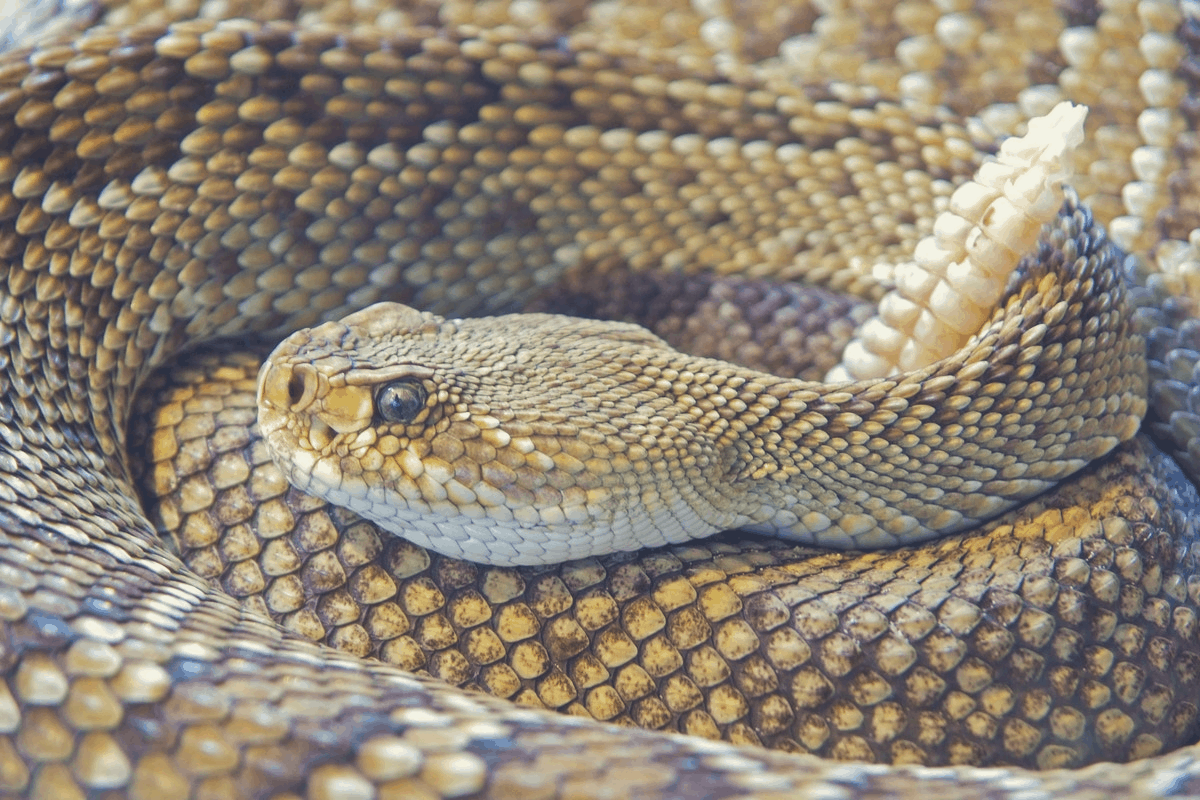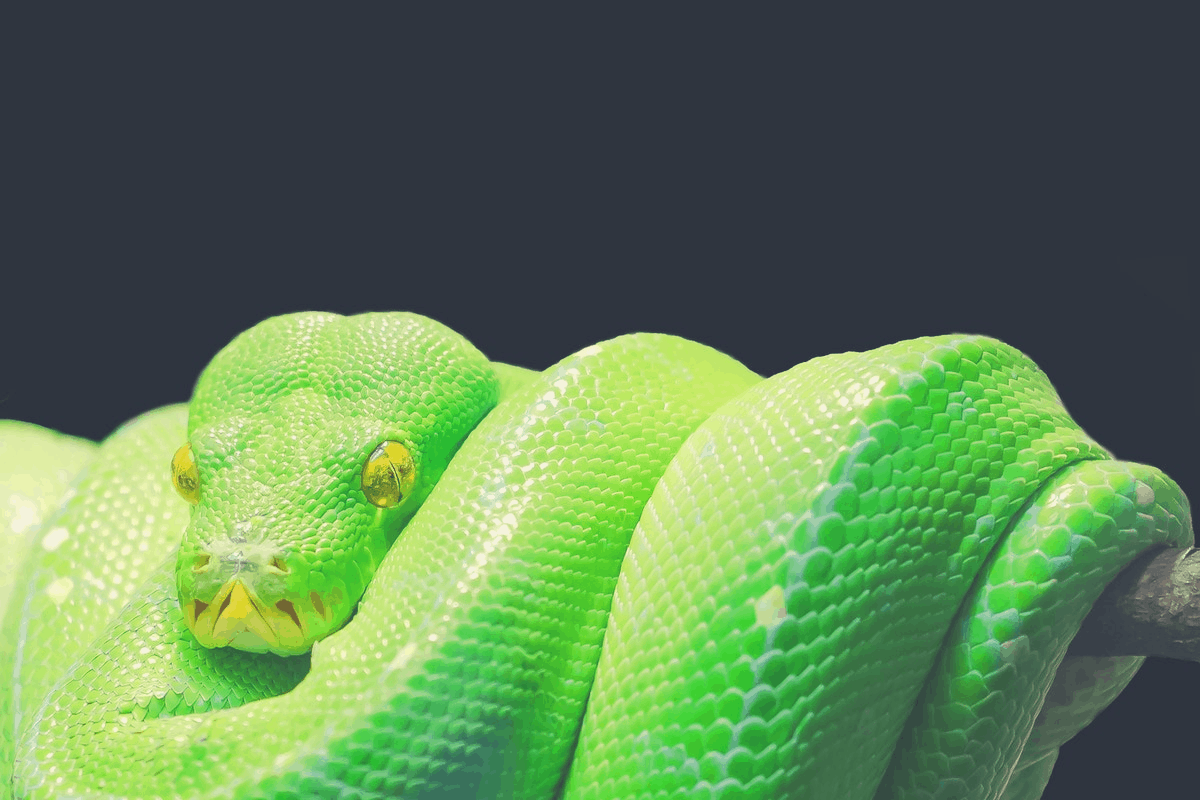Whether you own a pet snake or love the idea of getting one of these beautiful but often misunderstood creatures at home, learning as much information as possible can be enlightening.
One of the common questions current and prospective snake owners ask is whether snakes sleep at all? If yes, whether they snooze with their eyes open? This is a fair question because the eyes of snakes always seem open no matter what time of day it is.
Do snakes sleep with their eyes open?
Snakes sleep with their eyes open due to the lack of eyelids. Therefore the eyes stay open day and night regardless of their state of wakefulness at any given point in time.
How do you Tell if A Snake Is Sleeping?
After confirming that snakes sleep with the eyes open, the next logical step is finding out how to differentiate a sleeping Ball Python or Boa Constrictor from one that is awake.
Here are a few ways to determine whether a snake is getting some shuteye or not.
Body Positioning: This is one of the key clues that can give up the wakefulness of a snake or otherwise. Many species of the popular reptile curl into a ball and hide their heads when they hit snooze mode. This can be a good giveaway especially when a particular serpent has been in that position for hours without moving.
Disorientation: It can take some time to kick back into full alertness after being woken up from deep slumber as humans. Snakes experience a similar reaction when they’re woken up abruptly. This can spring up feelings of confusion and disorientation immediately it happens and it may take some time before they can settle.
Immobility and Limp Bodies: Like other pets, snakes can grow to recognize and trust their owners over time, showing signs of full relaxation even when picked up. However, lifting a pet snake from the ground or tank after an abrupt wake up can lead to a lot of confusion. They may respond by staying immobile and going limp as a form of resistance. But, snakes loosen up once they wake up fully and realize the presence of a familiar face.
No Tongue Flicking: Tongue flicking is synonymous with snakes, an action taken to sense the air for any chemicals that could be detrimental to their survival. If a pet snake goes several minutes or hours without flicking the tongue then you can safely assume that it is happily savoring the delights of Dreamland. Upon arousal, the same snake typically begins the routine process of tongue flicking again.
Pupil Rebooting: Observers of nocturnal snake species such as the night snake have reported noticing the pupils sort of “rebooting” after being awakened from slumber. The pupils of such serpents usually come with a thin slit but it immediately pulses larger for a brief moment before returning to its original size. This happens in realtime after a sleeping snake is aroused.
Why do not Snakes have eyelids?

One of the most peculiar things about snakes is the lack of eyelids. Most people never really pay attention to the bodies of snakes until they get their first one as a pet. That is when the reality of these beasts having no eyelids finally dawns.
Why do snakes have no eyelids? Well, serpents move by crawling on the ground in the wild and the presence of eyelids would expose them to dirt, debris, and all sorts of unwanted particles.
Instead, a layer of protective scale popularly known as Spectacles covers each eye to preserve their vision as they crawl through all kinds of environments in the woods.
The Spectacles also keep the eyes moisturized for effective functioning at any point in time as extremely dry eyes can be detrimental to a snake’s comfort. This protective layer is shed together with the snake’s skin and it is not uncommon to see the serpent’s eyes turn blue during the shedding process.
The frequent shedding of the eye scales ensures that the snake can get maximum protection for the eyes just like the skin.
Do Snakes Blink?
https://www.youtube.com/watch?v=_z3I3ir0sj8
With the lack of eyelids now established as a fact, you might wonder whether snakes blink like humans and pets such as dogs.
Do snakes blink? The answer is no. Blinking in snakes is impossible due to the absence of eyelids. Instead, snakes have protective eye scales known as Spectacles that enable them to explore the roughest environments in the wild without exposing the eyes to danger.
Where Do Snakes Sleep In Winter?
Cold weather can take a heavy toll on the bodies of snakes. This is because these beasts are cold-blooded meaning they have no way of self-regulating during extremely low-temperature periods.
They, therefore, survive in the winter months by staying dormant in relatively warm areas. Popular spots where snakes like to sleep during winter may include:
- Caves
- Dens
- Tree stumps
- Deep caverns
- Basements
- Sheds
- Garages
I love wearing the LaCrosse Men’s Alpha 16-inch Waterproof Hunting Snake Boots from Amazon in the woods. It protects my feet and legs from accidentally getting bitten by snakes. It is highly recommended.
What Do Snakes Do During The Day?
The activity level of a snake is determined by the prevailing temperatures in the environment at any point in time as well as the type of breed.
Diurnal Breeds: They operate like humans by staying active during the day and sleeping at night. During summer, these snakes move around to find food and mating partners as well as bask in the sun to increase their internal body temperatures. A few common diurnal breeds may include the common garter snake, skin snakes, and rat snakes.
Nocturnal Breeds: These breeds sleep all day and become active during the night. The Ball Python is the most popular nocturnal breed of snakes.
How Long Do Snakes Sleep?
The average snake sleeps for 16-20 hours per day depending on factors such as age and size as well as what time of the year it is. Snakes tend to sleep more during winter and other cold periods of the year – a process called brumation.
Brumation enables reptiles such as snakes to go into a hibernation-like state where they conserve body heat to be able to survive through harsh temperatures due to their natural cold-blooded tendencies.
Snakes typically enjoy longer snoozes immediately after feeding as that enables the food to digest.
Conclusion
It is confirmed – snakes do sleep with their eyes open unlike humans and other mammals. This is because these beasts have no eyelids to enable the shutting and opening of the eyes during slumber. Instead, they have a protective scale-like layer known as Spectacles that offer protection as they slither through mud, water, leaves, and other harsh environments in search of food and other essentials.
Differentiating between a sleeping snake and one that is awake can be tricky and requires some hard work. However, most snakes curl up and hide their heads during sleep so that can be a simple giveaway.
